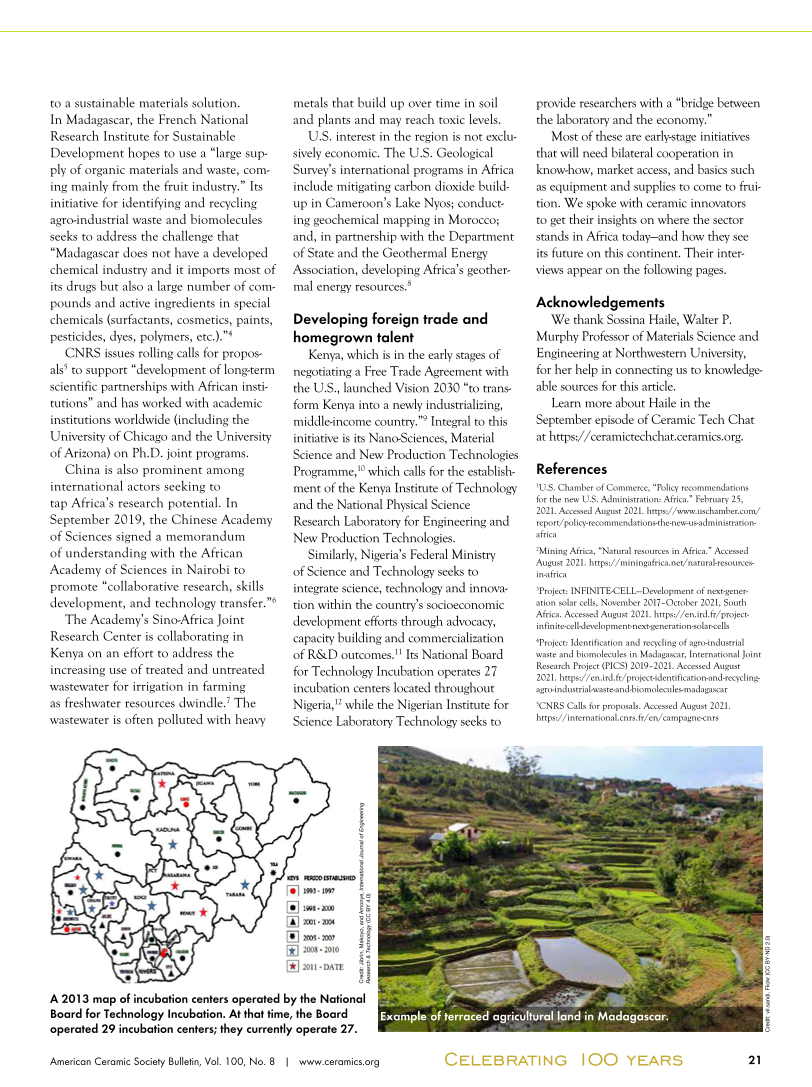21 American Ceramic Society Bulletin, Vol. 100, No. 8 | www.ceramics.org Celebrating 100 years to a sustainable materials solution. In Madagascar, the French National Research Institute for Sustainable Development hopes to use a “large sup- ply of organic materials and waste, com- ing mainly from the fruit industry.” Its initiative for identifying and recycling agro-industrial waste and biomolecules seeks to address the challenge that “Madagascar does not have a developed chemical industry and it imports most of its drugs but also a large number of com- pounds and active ingredients in special chemicals (surfactants, cosmetics, paints, pesticides, dyes, polymers, etc.).”4 CNRS issues rolling calls for propos- als5 to support “development of long-term scientific partnerships with African insti- tutions” and has worked with academic institutions worldwide (including the University of Chicago and the University of Arizona) on Ph.D. joint programs. China is also prominent among international actors seeking to tap Africa’s research potential. In September 2019, the Chinese Academy of Sciences signed a memorandum of understanding with the African Academy of Sciences in Nairobi to promote “collaborative research, skills development, and technology transfer.”6 The Academy’s Sino-Africa Joint Research Center is collaborating in Kenya on an effort to address the increasing use of treated and untreated wastewater for irrigation in farming as freshwater resources dwindle.7 The wastewater is often polluted with heavy metals that build up over time in soil and plants and may reach toxic levels. U.S. interest in the region is not exclu- sively economic. The U.S. Geological Survey’s international programs in Africa include mitigating carbon dioxide build- up in Cameroon’s Lake Nyos conduct- ing geochemical mapping in Morocco and, in partnership with the Department of State and the Geothermal Energy Association, developing Africa’s geother- mal energy resources.8 Developing foreign trade and homegrown talent Kenya, which is in the early stages of negotiating a Free Trade Agreement with the U.S., launched Vision 2030 “to trans- form Kenya into a newly industrializing, middle-income country.”9 Integral to this initiative is its Nano-Sciences, Material Science and New Production Technologies Programme,10 which calls for the establish- ment of the Kenya Institute of Technology and the National Physical Science Research Laboratory for Engineering and New Production Technologies. Similarly, Nigeria’s Federal Ministry of Science and Technology seeks to integrate science, technology and innova- tion within the country’s socioeconomic development efforts through advocacy, capacity building and commercialization of R&D outcomes.11 Its National Board for Technology Incubation operates 27 incubation centers located throughout Nigeria,12 while the Nigerian Institute for Science Laboratory Technology seeks to provide researchers with a “bridge between the laboratory and the economy.” Most of these are early-stage initiatives that will need bilateral cooperation in know-how, market access, and basics such as equipment and supplies to come to frui- tion. We spoke with ceramic innovators to get their insights on where the sector stands in Africa today—and how they see its future on this continent. Their inter- views appear on the following pages. Acknowledgements We thank Sossina Haile, Walter P. Murphy Professor of Materials Science and Engineering at Northwestern University, for her help in connecting us to knowledge- able sources for this article. Learn more about Haile in the September episode of Ceramic Tech Chat at https://ceramictechchat.ceramics.org. References 1 U.S. Chamber of Commerce, “Policy recommendations for the new U.S. Administration: Africa.” February 25, 2021. Accessed August 2021. https://www.uschamber.com/ report/policy-recommendations-the-new-us-administration- africa 2 Mining Africa, “Natural resources in Africa.” Accessed August 2021. https://miningafrica.net/natural-resources- in-africa 3 Project: INFINITE-CELL—Development of next-gener- ation solar cells, November 2017–October 2021, South Africa. Accessed August 2021. https://en.ird.fr/project- infinite-cell-development-next-generation-solar-cells 4 Project: Identification and recycling of agro-industrial waste and biomolecules in Madagascar, International Joint Research Project (PICS) 2019–2021. Accessed August 2021. https://en.ird.fr/project-identification-and-recycling- agro-industrial-waste-and-biomolecules-madagascar 5 CNRS Calls for proposals. Accessed August 2021. https://international.cnrs.fr/en/campagne-cnrs Example of terraced agricultural land in Madagascar. A 2013 map of incubation centers operated by the National Board for Technology Incubation. At that time, the Board operated 29 incubation centers they currently operate 27. Credit: vil.sandi, Flickr (CC BY-ND 2.0) Credit: Jibrin, Makoyo, and Amonye, International Journal of Engineering Research & Technology (CC BY 4.0)
(c) 2024 American Ceramic Society. All Rights reserved.




















































